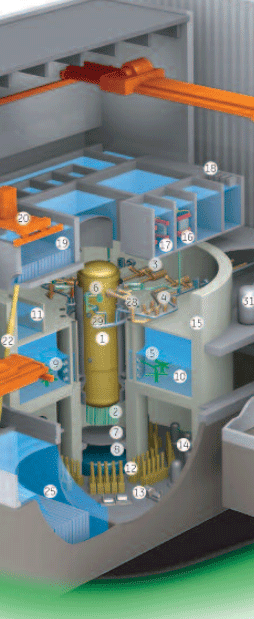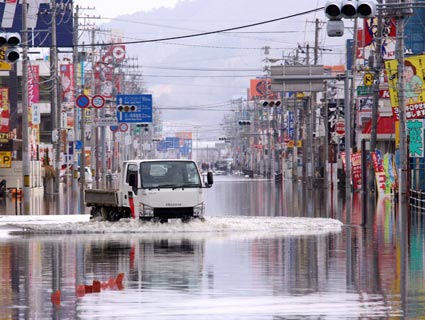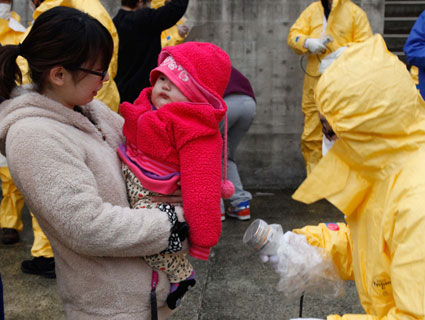 GE’s ESBWR reactor (passive cooling system is #17)
GE’s ESBWR reactor (passive cooling system is #17)
EDITOR’S NOTE: On Monday, this story was updated with responses from GE.
The nuclear industry likes to claim that each new reactor model is safer than the last. The unfolding nuclear emergency in Japan suggests otherwise.
A major source of the problems at the Fukushima Daiichi nuclear plant is its inability to cool down its overheating reactors without electricity, which was knocked out by the earthquake and tsunami. Missing from most of Fukushima’s reactors is a passive cooling system that operates without electricity. Phased out by General Electric just as Fukushima was being constructed in the early 1970s, the old system could have operated even after the earthquake and tsunami wiped out the plant’s electrical supply and diesel generators. “It can go on essentially forever” without electricity, says Mujid Kazimi, a professor of nuclear engineering at MIT. If it had been in use at Fukushima, he adds, it could have significantly slowed down the plant’s overheating problems.
General Electric developed passive cooling systems for use in its boiling water reactors, which were first introduced in the 1950s. Its last passively cooled reactor, the BWR3, debuted in the late 1960s. The BWR3’s backup cooling system runs entirely on gravity and steam generated by the reactor. As the steam rises inside the reactor vessel, it is captured by an isolation condenser, cooled off, and pumped back towards the hot core by a gravity-driven injection system. “Something that can circulate on its own would be very helpful” at Fukushima, Kazimi says.
But passive cooling is no guarantee against disaster. The steam in the reactor will boil off after six to eight hours if more water isn’t added, which might have been what happened before the plant’s Unit 1 reactor, its only BWR3, caught fire on Saturday. It’s also possible that Unit 1 was compromised by the earthquake or tsunami. A spokesman for GE, Michael Tetuan, said that GE doesn’t yet have enough information to compare how its different reactor models fared in the disaster.
GE has dealt with Japan’s nuclear crisis in part by trying to distance its older technologies from its newer ones. “BWR technology has evolved; each design more simple than the previous,” says a fact sheet on the company’s nuclear crisis website. “As a result, each generation of BWR has provided increased safety and improved economics.”
Yet GE’s shift away from passive cooling technologies during the 1970s illustrates how some “improvements” come with trade-offs. Tetuan says that GE abandoned the passive cooling system not because it didn’t work, but because the new system could keep water over the fuel rods even in the event of a partial pipe break—a perceived safety benefit. Kazimi also speculated that it may have been harder to seal off the old system inside a containment dome. But the airtight domes at Fukushima have proven to be of limited value; Japanese plant operators have been forced to vent them to release radioactive steam building up inside.
Tellingly, GE has revived its passive cooling technology in its next-generation prototype reactor, the Economic Simplified Boiling Water Reactor. Tetuan says that GE first began researching a new passive cooling system in the wake of the Three Mile Island disaster, when utilities requested reactors that were simpler to operate, had fewer components, and didn’t depend on diesel generators for backup. A fact sheet on the ESBWR brags that its “passive design features, such as passive containment cooling, reduce the number of active systems, increasing safety.” GE claims that ESBWR is so safe, in fact, that humans would be better off spending their time worrying about threats from outer space. The company figures that a large asteroid is 11 times more likely to strike Earth in the next 100 years than the ESBWR is to fail.
Of course, as Japan shows, improbable disasters actually happen, and when they do, they can take out some pretty fancy nuclear plants.













